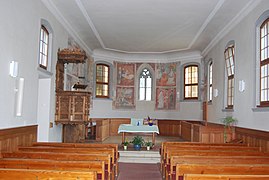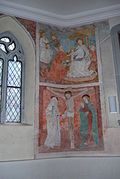Ganterschwil
| Ganterschwil | ||
|---|---|---|
| State : |
|
|
| Canton : |
|
|
| Constituency : | Toggenburg | |
| Political community : | Bütschwil-Ganterschwil | |
| Postal code : | 9608 | |
| former BFS no. : | 3403 | |
| Coordinates : | 724 188 / 249357 | |
| Height : | 606 m above sea level M. | |
| Area : | 8.01 km² | |
| Residents: | 1186 (December 31, 2012) | |
| Population density : | 148 inhabitants per km² | |
|
Parish church of Ganterschwil |
||
| map | ||
|
|
||
Ganterschwil is a village and until December 31, 2012 was a political municipality in the Toggenburg constituency of the canton of St. Gallen in Switzerland . On January 1, 2013, the municipality of Ganterschwil merged with Bütschwil to form the municipality of Bütschwil-Ganterschwil .
geography
Ganterschwil lies on a plateau between the Thur and Necker rivers . Numerous individual farms and the hamlets of Äwil, Anzenwil, Bleiken, Ötschwil and Tobel belong to Ganterschwil. The community bordered Bütschwil to the west, Lütisburg to the north , Mogelsberg to the east and Oberhelfenschwil to the south . The municipal boundary was formed on three sides by the rivers Thur and Necker, Ganterschwil can only be reached from the south without crossing a bridge.
history
Ganterschwil was first mentioned in a document in 778/779. The Abbeys of St. Gallen and Magdenau as well as the Counts of Toggenburg owned real estate in Ganterschwil. In addition to their own people, members of the lower nobility, e.g. B. Wenzel von Ganterschwil in 1102. In the 15th century Ganterschwil belonged to the Bailiwick of the Counts of Toggenburg, until 1798 to the Mogelsberg court . After the Toggenburg was sold to the Abbot of St. Gallen in 1468, Ganterschwil was subordinated to the Landvogt von Lichtensteig.
The patronage right of the church originally consecrated to Mary was mentioned in 1361 and belonged to the Abbey of St. Gallen. The hermitage with chapel, founded near Ötschwil in 1375, was closed in 1865. After 1528 a Reformed parish was formed, which has since existed alongside the Catholic parish. After the construction of a Catholic church in 1939, the parish parish church was left to the Reformed. The village law, mentioned in 1621, regulated the internal order.

Mainly grain and oats were grown and processed in three mills. From the 18th century, contract weaving gained in importance. In Hengarten was until 1863 tuff mined. Small textile factories like those of Johann Georg Berlinger developed from family businesses . In the 19th century the cattle and dairy industry replaced the cultivation of grain. In 1992 there were two cheese factories. The private secondary school Bütschwil-Ganterschwil, founded in 1863, was transferred to the two communities in 1913. After the crisis in the textile industry from 1918 onwards, only smaller businesses could be established. In 2000 around half of the working population was employed in the service sector. The home founded in 1913 by the reformed pastor Alfred Lauchenauer for socially disadvantaged children developed into the Sonnenhof child and youth psychiatric center.
On November 27, 2011, votes on a municipal merger took place in Ganterschwil and Bütschwil . The vote was accepted in Ganterschwil with a yes share of 54%. The new community was founded on January 1, 2013 and is called Bütschwil-Ganterschwil .
population
| year | 1800 | 1834 | 1900 | 1950 | 2000 |
| Residents | 681 | 732 | 868 | 971 | 1111 |
In 2000, 603 Ganterschwiler were Catholic and 398 were Reformed.
traffic
Roads lead from Ganterschwil to the neighboring towns of Lütisburg, Bütschwil and Oberhelfenschwil. Nassen , Degersheim , Mogelsberg and Brunnadern can be reached via a road connection running parallel to the Necker . Postbus lines connect Ganterschwil every half hour with the Bütschwil train station and with Lütisburg, and with Flawil during rush hour .
economy
There are many smaller businesses in Ganterschwil that offer jobs. The best-known company is Berlinger , which was active in tape production and today plays a leading role worldwide in the production of doping control systems (forgery-proof sample glasses).
Attractions
In the parish church, under the protection of the Swiss Confederation, there are frescoes from the Middle Ages that were discovered and restored in 1941.
Three covered wooden bridges lead over Thur and Necker to Ganterschwil.
Wooden bridge Anzenwil from Brunnadern over the Necker
Web links
Individual evidence
-
↑ a b c d e f g Beat Bühler: Ganterschwil. In: Historical Lexicon of Switzerland .
These sections are largely based on the entry in the Historical Lexicon of Switzerland (HLS), which, according to the HLS's usage information, is under the Creative Commons license - Attribution - Distribution under the same conditions 4.0 International (CC BY-SA 4.0). - ↑ StiASG , Urk. I 61. Online at e-chartae , accessed on June 19, 2020.
- ^ Hans Büchler : Bütschwil. In: Historical Lexicon of Switzerland .
- ↑ Association resolution
- ↑ 80.768 Bütschwil - Ganterschwil - Lütisburg. In: Official course book, timetable year 2020
- ↑ 80.767 Ganterschwil - Lütisburg - Rindal - Flawil. In: Official course book, timetable year 2020











